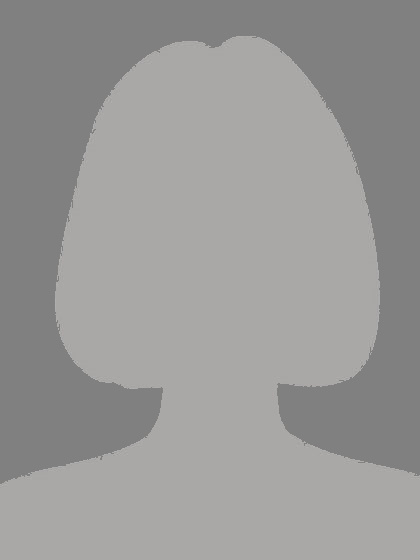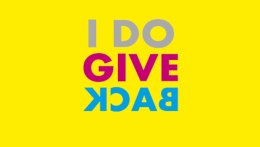No (e)scape
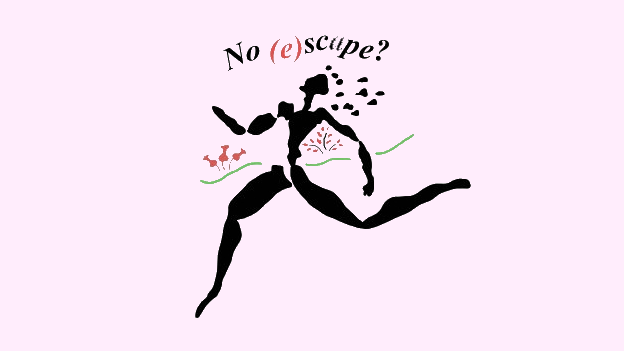
„No (e)Scape? – Towards a Relational Archaeology of Man, Nature, and Thing in the Aegean Bronze Age" - a conference at the Ruprecht-Karls-University in Heidelberg
"Of course we want to thank the DAAD-Stiftung for the financial support of our conference. Thanks to this support, we were able to give junior academics the opportunity to present their research and at the same time practise important skills for their future professional lives as archaeologists."
In the spring of 2018 a conference by the name of "No (e)scape? - A Relational Achaeology of Man, Nature and Thing" took place at the Ruprecht-Karls-University in Heidelberg. International students engaged with archeological findings by applying current theories of neighboring disciplines (such as ethnology and cultural anthropology).
In the following account the organizing committee shares details of the three-day event:
The idea of organising a conference on the Aegean Bronze Age had been circulating among the students of our institute for some time. It is rare for us as students to have an opportunity to present our own thoughts to the research community and establish contact with people outside of our own university. We also believed that presenting a paper at a conference pre-sents for many an important component of one’s future professional life and should therefore be practised during our academic studies, outside of the “comfort zone” of a seminar. These considerations gave rise to a project, which we, the master students at the Institute for Classi-cal Archaeology at Ruprecht-Karls University in Heidelberg, finally implemented on 23 to 25 March 2018 as a student initiative.
Our conference entitled “No (e)scape? – Towards a Relational Archaeology of Man, Nature, and Thing in the Aegean Bronze Age” was intended to give international master students and doctoral candidates an opportunity to see the Aegean Bronze Age from a vantage point that focuses not only on the human factor but also examines multiple influences of the environ-ment on human life, action and experience. The theoretical framework for the event was the concept of relational archaeology. This theory served as a heuristic approach to identifying the processes that develop around humans, landscapes, animals and objects which are all connected with one another in space and time. The enormous potential of this theoretical ap-proach led to a multitude of paper applications, which ultimately resulted in a total of 24 con-tributions by junior academics from 17 different universities in Europe and North America. During the three days of the conference, various junctures in the Aegean Bronze Age, such as objects, constructed and natural environments, resources and human ingenuity were ex-amined from different viewpoints.
Friday 23 March 2018
After a greeting delivered by us as the organisational committee and a welcoming address by Prof. Diamantis Panagiotopoulos, Director of the Institute for Classical Archaeology at the University of Heidelberg, the conference began with the first section entitled “Of Man and Thing”. The presenters in this session used case studies on the relationships between human beings and objects to show that there are a multitude of reciprocal relationships between those objects and their human environments. For instance, Alexander Aston (Oxford) proved that objects, as for example Cycladic idols, have the potential of fostering and motivating feel-ings of attentiveness and of impacting social cognition.
Dora Olah (Sheffield), by contrast, showed that those same figurines can also be seen as “storytellers” of human connections and interactions. This strong impact of humans in prehistoric social dimensions was also demonstrated by a case study of “talisman” seals, part of the presentation by Barbara Morda (Kent). But not only the Bronze Age society influenced the interaction of “humans and things”, modern science also contributes with its discourse on the change in perception of these cate-gories, as Angelika Hudler (Vienna) showed with the case of gemmae dubitandae. The day closed with a talk by guest speaker Prof. Georgos Vavouranakis of the University of Athens. In his presentation, he discussed the development and methods of relational archae-ology and critically illuminated the opportunities and limitations of this approach.
Saturday 24 March 2018
The second day began with the section entitled “Live and Let Leave” and consisted of a wide range of methods and an equally broad spectrum of research topics. The first presentation of the section by Angela Ratigan (Heidelberg) informed the audience of the possibility of study-ing the constructed environment through digital reconstruction of building complexes. Ar-chaeological findings provide clues and information for such virtual reconstructions that help to understand the functionality of a constructed environment.
Another approach to under-standing the functionality of buildings was presented by Piotr Zeman (Poznań). With the aid of the theoretical construct of entanglement theory, he attempted to decipher the settlement networks of the lower cities of five Mycenaean palaces. The two following talks focused on the funeral context of the Bronze Age as another area of social life that provides significant insights into the interaction between humans and their environment. First, Alexandra Vouza (Groningen) introduced a case study on Asine, where she examined chamber tombs as ac-tive agents in a dialectic relationship between humans and the natural landscape. A second case study, presented by Yannis Chatzikonstantinou (Thessaloniki), examined the funeral traditions in Macedonia, in order to reconstruct the development of social identities based on the funeral practices of the Late Bronze Age society in Northern Greece.
The last two presen-tations focused on the maritime activities that are considered an essential component of Bronze Age culture in the Aegean. The starting point of the presentation by Mia Marijan (Za-greb) was the island of Vela Palagruža in the middle of the Adriatic. It was used as a stopover point for sea voyages in the Bronze Age, and obsidian from Melos found on the island is being discussed as an indicator for the mobility of Cycladic seafarers. Finally, Victoria Alliata (Hei-delberg) presented the southern Italian region of Apulia, which based on archaeological dis-coveries was clearly influenced by the Aegean culture and must have served as a major junc-tion for Bronze Age seafaring.
The next section was entitled “Man and Nature. Friend or Foe?” and focused on nature itself as an omnipresent factor in the Aegean Bronze Age. The impact of the natural environment on human beings can manifest on many levels of everyday social life, such as the iconogra-phy of various image bases and objects. For example, Vasileios Karaiskos (Athens) showed that the influence of nature on human thinking is reflected in Late Bronze Age ceramics paint-ing by natural motifs, particularly maritime images, which were integrated or adapted by dif-ferent social groups throughout the Mediterranean region. As a counterpoint, Julia Binnberg (Oxford) postulated that bird-shaped vessels and bird figurines used for holding liquids act as passive symbols for nutrition and wealth as elements of the natural world or show their effect in the interaction with humans in rituals such as libations. After this, Filip Franković (Heidel-berg) used the case study of the “Lion Warriors” to illustrate how elitist identity could be formu-lated by instrumentalising symbols of power like weapons, lavish clothing or jewellery, or even the steeled body of a warrior itself. The talk by Stylianos Tzirakis (Crete) demonstrated that not only worldly power but also religious significance could be conveyed through attributes, as in the example of snake images, which express social identity and religious convictions.
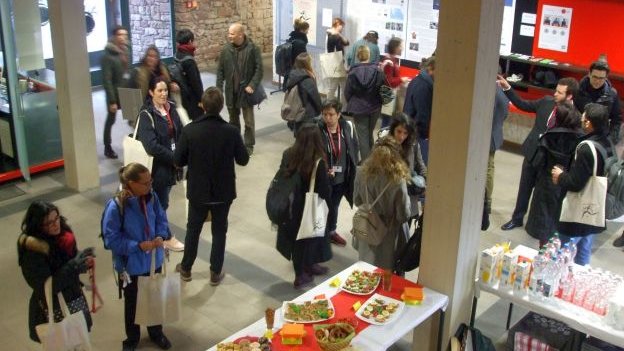 Privat
Privat
The last section of the day entitled “Society meets Nature” dealt specifically with the issue of development and perception of landscapes. First, Tatiana Andreovits, Angeliki Kita and Danai Theodoraki (Thessaloniki) presented the aspect of the wilderness of Macedonia with regard to the interdependence of humans and nature. A different approach to settlements in Bronze Age Macedonia was introduced by Magda Anthrakidou (Thessaloniki), who used GIS-supported analysis to examine the spatial organisation of settlements with respect to their nat-ural environment.
In the next presentation, Katarzyna Dudlik (Poznań) discussed the topic of cultural identity using the example of the island of Kos in the outer Aegean. The section closed with an excursion into the field of geology, which as an independent academic disci-pline applying inter-disciplinary methods provided new insights into the dependence of human beings on their natural environment and touched on the dynamics of human reactions to sud-den environmental changes. In the context of the relational aspects, Krista Evans (Hawaii) presented the Late Bronze Age volcanic eruption on Thera and its impact on affected social groups.
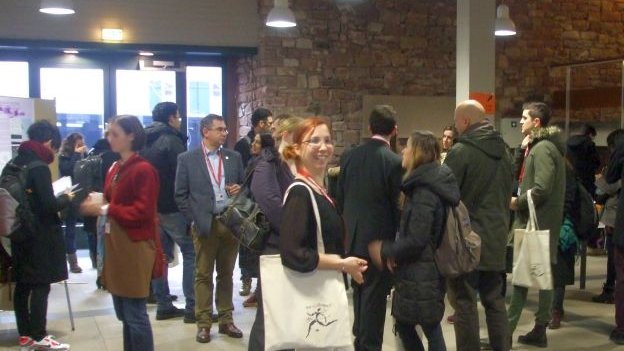
Privat
Since our speakers were eager to explore not only the university but also the historic city of Heidelberg, Nasser Ayash offered the presenters a tour of the city to round out the day. After the tour, the Institute for Classical Archaeology invited all participants to a dinner at the historic restaurant “Zum Goldenen Schaf”, where, surrounded by illustrations from the Codex Ma-nesse, initial contacts were intensified. The dinner guests gladly took advantage of the oppor-tunity to get to know one another outside of the academic framework of the conference. Since many speakers came from different countries, such as Great Britain, Greece, Croatia but also North America, it turned out to be an interesting and lively evening with a wide range of conversation topics, not all of which involved the Bronze Age.
Sunday 25 March 2018
The last day of the conference began with the section “Living Ritual and Landscape”, which included contributions addressing different approaches to questions of embedding rituals in the landscape and the effect of landscapes on the character of rituals. Rachel Dewan (Toron-to) showed that Cretan miniature vessels represented an important juncture in the relational network between landscapes and worshippers as artefacts in peak sanctuaries. Konstantinos Zikakis (Heidelberg) expounded on the topic of Cretan peak sanctuaries by demonstrating that their functions could also be fulfilled elsewhere, so the landscape was not an imperative criterion for these sanctuaries. Georgia Fakarou (Athens) explained that the mountainous landscape nevertheless had a strong influence using the case study of the “deity with raised arms”, which she interpreted as an embodiment of the landscape of Minoan peak sanctuar-ies.
The following session was called “The Escape: Think or Act?”. The presentations in this sec-tion addressed different capabilities of human beings to overcome existing environmental conditions and change their environments to adapt them to human needs. These strategies could be very different. Eirini Petridou (Rhodes) used the example of the “Youth God” to ex-amine ritual efforts by human beings at appeasing natural phenomena. A different approach was presented by Abhazar Shobairi (Athens), who introduced technological endeavours dur-ing the establishment of Mycenaean irrigation systems. The last section called “Exploring Technology and Production” encompassed the presentation by Effimia Angeli (Nottingham), who discussed the development of navigation techniques and shipbuilding during increasing maritime activities within the Bronze Age Mediterranean. The closing talk of the conference was a summary of the presented ideas delivered by Diana Wolf. Most of the presentations were recorded via live stream and are freely accessible on our YouTube channel.
On the whole, the conference not only served its primary intended academic objective, but developed into a platform of international exchange among students. One of the results is a cooperation with students of the Archaeological Institute of Adam Mickiewicz University in Poznań, which is currently preparing a continuation of the conference format this coming year in Poland. For the future, we hope that the international platform for young archaeolo-gists we created in Heidelberg can take place at various universities in different countries. The highly positive feedback we received from a number of participants and the continuation of the project in 2019 provides encouragement for such a development. Finally, we must mention that the conference resulted not only in purely academic “network-ing” but sparked new friendships even beyond that at the personal level.
Of course we want to thank the DAAD-Stiftung for the financial support of our conference. Thanks to this support, we were able to give junior academics the opportunity to present their research and at the same time practise important skills for their future professional lives as archaeologists. Over the course of three days, new and creative suggestions for researching social groups in the Late Bronze Age Aegean were introduced, productive discussions were held and international contacts established. The conference team learned a lot as well, start-ing with the aspect of financing and organisational details and ending with creative problem solving when things did not work out as planned right away. At the professional level as well, we had to gather lots of additional knowledge in order to select appropriate contributions and guide the audience through the talks during the conference. Apart from new insights about the Aegean Bronze Age, we and all participants gained new key competences for our future pro-fessional lives. We hope very much that our student initiative was an enriching experience for all participants and that it will be successfully continued in Poland in 2019, and hopefully at other universities in years to come.
As of fall 2018. The German version is the original.

